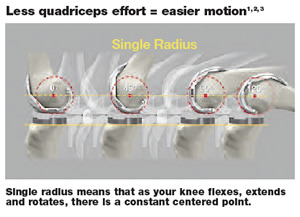Dedicated to Our Patients


 Stryker knee replacements are different than
traditional knee replacements because they are
designed to work with the body to promote easier
motion,1,2,3 and a study has shown a more rapid
return to functional activities after surgery.2 This is
due to the single radius design of the knee implant.
Single radius means that as your knee flexes, the
radius is the same, similar to a circle, requiring
less effort from your quadriceps muscle.1,4,6
Stryker knee replacements are different than
traditional knee replacements because they are
designed to work with the body to promote easier
motion,1,2,3 and a study has shown a more rapid
return to functional activities after surgery.2 This is
due to the single radius design of the knee implant.
Single radius means that as your knee flexes, the
radius is the same, similar to a circle, requiring
less effort from your quadriceps muscle.1,4,6
Because the thigh muscle (the quadriceps) is attached to your knee, it is unavoidably involved in the surgery. Therefore, the quadriceps muscle can become a source of discomfort or pain during your recovery period. The quadriceps muscle plays an important role in your ability to move your legs so it also has a major impact on your recovery and how quickly you can get back to living your life.2
Knee implants designed to last longer5
Several factors influence how long an implant will
continue to perform. Stryker knees are designed
to resist wear in many ways — they use advanced
bearing surfaces; they're balanced to help avoid
excessive stress in any one spot; and, they're sized
to better fit your personal anatomy.
X3 Advanced Bearing Technology has
demonstrated up to 96% decrease in wear in
laboratory testing compared to competitive
premium bearing technologies.5
Stryker Corporation or its divisions or other corporate affiliated entities own, use or have applied for the following trademarks or service marks: Stryker and X3. All other trademarks are trademarks of their respective owners or holders.
References:
1. Ostermeier, S; Stukenborg-Colsman, C, Hannover Medical School
(MHH) Hannover, Germany 'Quadriceps force after TKA — a
comparison between single and multiple radius designs," Poster No.
2060 • 56th Annual Meeting of the Orthopaedic Research Society.
2. Harwin, S.F., Hitt, K, Greene, K.A. Early Experience with a New
Total Knee Implant: Maximizing Range of Motion and Function with
Gender-Specific Sizing Orthopedic Surgery, Surgical Technology
International, XVI. pgs 1-7.
3. Greene, K.A. Range of Motion: Early Results from the Triathlon®
Knee System, Stryker Literature Ref #LSA56., 2005.
4.Wang, H., Simpson, K.J., Ferrary M.S., Chamnongkich, S., Kinsey,
T, Mahoney, O.M., Biomechanical Differences Exhibited During Sit-
To-Stand Between Total Knee Arthroplasty Designs of Varying Radii,
JOA, Vol. 21, No. 8, 2006.
5. Stryker Orthopaedics Test Report: 06-013.
6. The effect of total knee arthroplasty design on extensor mechanism
function, JOA, Vol. 17, Issue 4, June 2002, pp. 416-421.